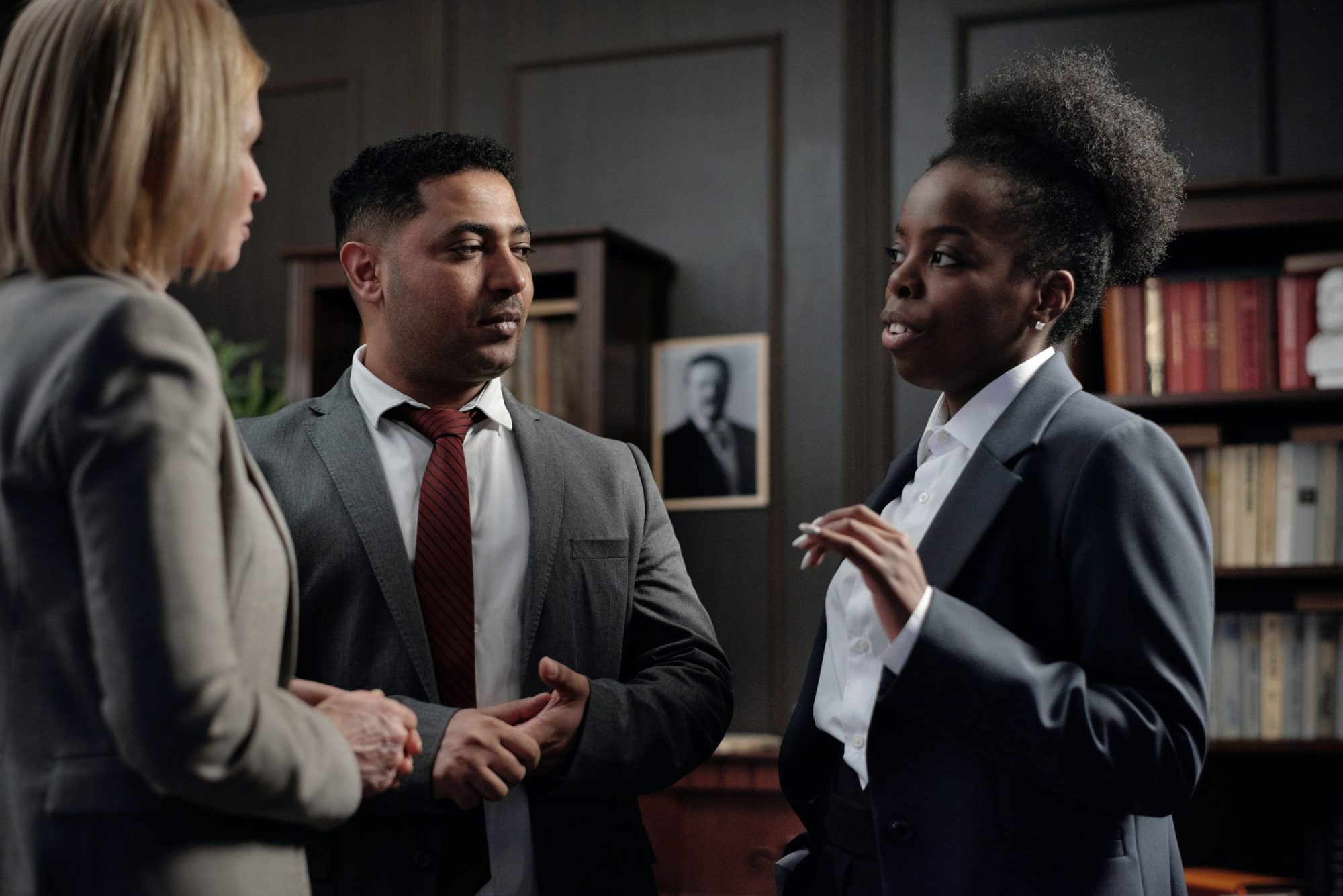Effective leadership communication is a vital ingredient in the recipe for professional success. It is the cornerstone of fostering a positive team culture and achieving better business outcomes.
So, what sets great leaders apart? They can communicate effectively with their team members, align efforts, inspire change, and gain trust.
In this blog post, we will delve into the essence of “how to communicate effectively as a leader,” essential skills, strategies for improvement, overcoming challenges, and the role of continuous learning. Let’s embark on this journey to master the art of effective leadership communication.
Key Takeaways
- Leadership communication involves active listening, clear expression, and the ability to adapt strategies for successful team collaboration.
- Essential leadership skills include active listening, clarity, empathy, adaptability, and body language.
- Strategies such as open questions & feedback can be used to enhance communication skills while overcoming common barriers like misinterpretation or cultural differences.

The Essence of Leadership Communication
Effective communication skills are essential for leaders to motivate transformation, coordinate endeavors, and build confidence, resulting in a productive team environment and improved business results.
Great leaders exhibit active listening, clear expression, and the ability to adapt to their employees and situations. This approach cultivates improved communication throughout the workplace and provides a collaborative, accessible environment that fuels success.
To excel in a leadership position, it’s crucial to employ strategies such as:
- asking open-ended questions
- providing input and feedback
- narrating stories and experiences
- adapting to varying communication channels
These strategies enhance your leadership communication skills and help you stay one step ahead in the ever-changing business landscape.
Essential Leadership Communication Skills
To effectively communicate with teams and realize professional success, leaders must possess good communication skills, including five key aspects: active listening, clarity, empathy, adaptability, and body language.
Let’s delve deeper into these essential skills and understand how they contribute to effective leadership communication.
Active Listening
Active listening is the practice of attentively hearing what team members have to say and building trust by comprehending their views, concepts, and grievances. It assists leaders in understanding their team more efficiently and fosters a collaborative work environment. To practice active listening, leaders should:
- Solicit opinions
- Record salient points
- Avoid distractions, including putting away cell phones, closing email inboxes, and focusing solely on the speaker.
When leaders actively listen, it showcases their genuine interest in their team members’ thoughts, motivations, and goals. This helps build stronger bonds and promotes open dialogue and better collaboration within the team.
Clarity
Clarity in communication refers to ensuring that others comprehend one’s message. It necessitates emphasizing a particular message or goal at any given time, averting misinterpretations, and being explicit in communication.
Clarity is essential in assisting leaders in establishing goals, tracking progress, and guaranteeing that team members comprehend their roles and obligations.
To ensure clarity in communication, it is advisable to use simple language, abstain from jargon, and provide examples to better explain one’s point. Employing such strategies, leaders can prevent misunderstandings, ensure a smooth flow of information within the team, and steer the organization towards its goals.
Empathy
Empathy is paramount in the realm of leadership communication. It is the capacity to comprehend and relate to the emotions of another individual, allowing leaders to better understand their team members and create a supportive environment.
A staggering 92 percent of participants in a recent survey asserted that empathy is still not given sufficient recognition.
Acknowledging and showing empathy for their employees’ struggles and difficulties allows leaders to sustain team unity and cultivate strong bonds among team members. Leaders should envision themselves in the position of employees and make judgments that are advantageous to them. This approach humanizes data, fosters open dialogue, and bolsters a sense of connection and understanding within the team.
Empathy is a powerful tool for positive change; it’s essential to practice empathy to harness its power.

Adaptability
Adaptability in communication is defined as the capacity to modify one’s communication style and approach in response to the particular requirements of a situation or audience.
It involves being flexible, open-minded, and able to alter the content and delivery of a message to effectively connect with others. Realizing how to tailor one’s communication is fundamental to impacting others and attaining organizational objectives.
Gaining insight into the audience by engaging in one-on-one conversations may be beneficial in delivering a speech tailored to them.
Moreover, comprehending the collective and customizing the message and manner of delivery is essential for addressing a large audience and ensuring each individual feels as if the speaker is communicating with them directly.
Being amenable to communication enables leaders to foster a closer connection with their audience, engender confidence, and establish a more productive communication setting.
Body Language
Body language can be defined as using physical behavior, expressions, and mannerisms to convey messages and emotions without using words. This includes:
- Gestures
- Facial expressions
- Posture
- Other nonverbal signals
These nonverbal cues can supplement or accompany verbal communication. Body language is important in ensuring the successful transmission of messages and establishing trust.
Leaders should be aware of the nonverbal cues they convey, such as eye contact and open gestures, which play a significant role in accurately conveying messages and building trust with their team members.
By being conscious of their body language, leaders can enhance their communication skills and create a more open and transparent work environment.
Strategies for Enhancing Leadership Communication Skills
Improving leadership communication skills is an ongoing process that requires dedication and effort. In this section, we will explore four strategies that can help leaders enhance their communication skills and foster a more collaborative and inclusive work environment:
- Asking open-ended questions
- Encouraging input and feedback
- Sharing stories and experiences
- Adapting to different communication channels
Asking open-ended questions is a great way for people to think more deeply about and reinforce key concepts.
Asking Open-Ended Questions
Open-ended questions are inquiries that cannot be answered with a simple ‘yes’ or ‘no’ and necessitate elaboration. Such questions commonly begin with words like ‘why,’ ‘how,’ and ‘what’ and encourage a comprehensive and detailed response. Open-ended questions stimulate a more extended conversation and permit a more thorough topic exploration.
Inquiring with open-ended questions allows leaders to:
- Delve into their employees’ perspectives, motivations, and objectives
- Fortify connections and nurture more effective collaboration
- Encourage team members to think critically and come up with innovative solutions
- Ultimately, it drives the organization toward success.
Encouraging Input and Feedback
The promotion of input and feedback enables leaders to:
- Acquire a more comprehensive knowledge of their team members’ opinions and concepts
- Contribute to the development of a culture of collaboration and trust
- Make informed decisions by soliciting feedback from team members
- Demonstrate their commitment to continuous improvement
Encouraging input and feedback enables leaders to pinpoint areas for improvement, address concerns, and foster a more transparent and open work environment. This helps enhance leadership communication skills and fosters team members’ sense of belonging and camaraderie.
Sharing Stories and Experiences
The exchange of stories and experiences can be beneficial for establishing relationships and trust between leaders and their team members. Personal anecdotes and experiences can help leaders connect with their team members, promote learning, and create a supportive environment.
Furthermore, sharing stories and experiences can foster a sense of connection and understanding within the team. Sharing their experiences and lessons learned allows leaders to present a more human side of themselves and create a relatable image for their team members.
This strengthens the bond between leaders and team members and creates an atmosphere where everyone feels comfortable sharing their own stories, ultimately promoting a culture of learning and growth.

Adapting to Different Communication Channels
Adapting to various communication channels enables leaders to extend their reach and guarantee that their message is received.
Additionally, it assists in cultivating a culture of openness and transparency. Leaders should communicate frequently through various channels, such as face-to-face conversations, videoconferencing, audio conferencing, emails, chats, and messaging.
Utilizing multiple communication channels not only ensures that important information is accessible to all team members but also maintains open dialogue within the team. Adapting to various communication channels equips leaders to effectively convey their message, address concerns, and create a more inclusive and collaborative work environment.
Overcoming Common Communication Barriers
This section will explore three common communication barriers—misinterpretation, resistance to change, and cultural differences—and discuss strategies to overcome them.
Addressing these barriers is crucial for ensuring effective team communication and organizational success.
Misinterpretation
Misinterpretation is a misunderstanding or misinterpreting a communication’s intended message or meaning.
It can result in confusion, conflict, and ineffective communication. To prevent misunderstandings, leaders should ensure clear and concise communication by using simple language, abstaining from jargon, and providing examples to better explain their points.
Taking measures to ensure communication clarity can help leaders prevent misunderstandings and ensure team members understand their roles and responsibilities, propelling the organization towards its goals.
Clear communication fosters a more transparent and open work environment, where team members feel comfortable openly expressing their concerns and ideas.
Resistance to Change
Change is inevitable, and leaders must be able to communicate the rationale behind changes to help team members adapt and embrace new initiatives. To do so, leaders should be explicit and brief when conveying the rationale behind changes and be receptive to inquiries and responses from team members.
Providing resources and education to assist team members in understanding changes and their benefits to the organization can help leaders assist team members in overcoming resistance to change.
Additionally, being available to questions and input from team members can further promote a sense of understanding and acceptance of new initiatives.
Cultural Differences
Understanding and respecting cultural differences is of paramount importance for effective leadership communication. It enables leaders to better understand their team members, cultivate trust, and create a collaborative and inclusive work environment. To identify and understand cultural differences, leaders can research the culture of their team members, actively observe their behavior, and inquire about their experiences.
Acknowledging cultural disparities, utilizing appropriate language, and respecting others’ beliefs and values can enable leaders to communicate effectively with people from diverse cultures.
This helps foster an inclusive and collaborative work environment and ensures that all team members convey important information accurately and comprehend.

The Role of Continuous Learning in Leadership Communication
Continuous learning is imperative for successful leadership communication, as it enables leaders to:
- Remain familiar with the most recent communication trends and methods
- Be aware of any fluctuations in the cultural landscape
- Better comprehend and address any communication barriers that may come to fruition
- Adapt to evolving team dynamics and organizational requirements
- Ensure effective communication throughout their careers
Self-improvement, however, can be challenging as it necessitates sustained education, self-evaluation, and growth. To overcome these challenges, leaders can seek assistance from programs like BetterUp, which can provide thought-provoking questions, aid in formulating a plan, and provide accountability.
Embracing continuous learning enhances leaders’ communication skills and propels their teams and organizations toward success.
Case Studies: Successful Leaders and Their Communication Styles
Examining the communication styles of successful leaders can provide valuable insights and inspiration for developing effective leadership communication skills.
For instance, Jack Ma, the founder of Alibaba Group, uses humor, storytelling, and personal anecdotes to engage with his employees and make complex ideas more understandable.
He also emphasizes the significance of empathy and attentiveness in communication, as well as being receptive to the views and opinions of others.
Richard Branson, the founder of Virgin Group, is another example of a successful leader with an effective communication style. He is known for:
- His use of clear and concise language to express his vision and mission
- The importance of transparency and honesty in all business communication
- The creation of a sense of community and collaboration
Gaining lessons from these successful leaders can help you hone your communication skills and enhance your leadership skills within your organization.
Summary
Effective leadership communication is the key to unlocking professional success, fostering a positive team culture, and achieving better business outcomes.
By focusing on essential communication skills such as active listening, clarity, empathy, adaptability, and body language and employing strategies to enhance these skills, leaders can effectively communicate with their teams and drive their organizations toward success.
Moreover, overcoming common communication barriers and embracing continuous learning can refine leadership communication skills. It’s time to unlock your full leadership potential and inspire your team to reach new heights!
Frequently Asked Questions
What is the most effective way for a leader to communicate?
An effective leader should focus on active listening, invite opinions and feedback, be mindful of their body language and non-verbal cues, and ask powerful questions to open the door for conversations.
Additionally, leaders should create a trusting environment by actively engaging in conversations and providing valuable responses.
What are three examples of how good leaders communicate?
Good leaders communicate authentically, actively listen, and are transparent. They can adapt their communication style, demonstrate clarity, ask open-ended questions, use short words to discuss hard things and humanize data to create value.
Furthermore, they set clear expectations, simplify and are direct, illustrate through stories, reinforce intent with body language, read the room, and make mission their mantra.
What are the 7 Cs of effective communication for successful leadership?
The 7 C’s of Effective Communication for Successful Leadership are Clear, Concise, Concrete, Correct, Coherent, Complete, and Courteous. These principles ensure clear communication between leaders and their teams, creating a more effective team dynamic.
What is leadership communication strategy?
Leadership communication is important for relaying critical information about an organization, including updates on change, culture, mission, and objectives. It requires effective communication channels, skills, and strategies for successful implementation.
What are the key components of effective leadership communication?
Effective leadership requires active listening, clear and concise expression, empathy towards colleagues, adaptability to different contexts, and mindful use of body language.
